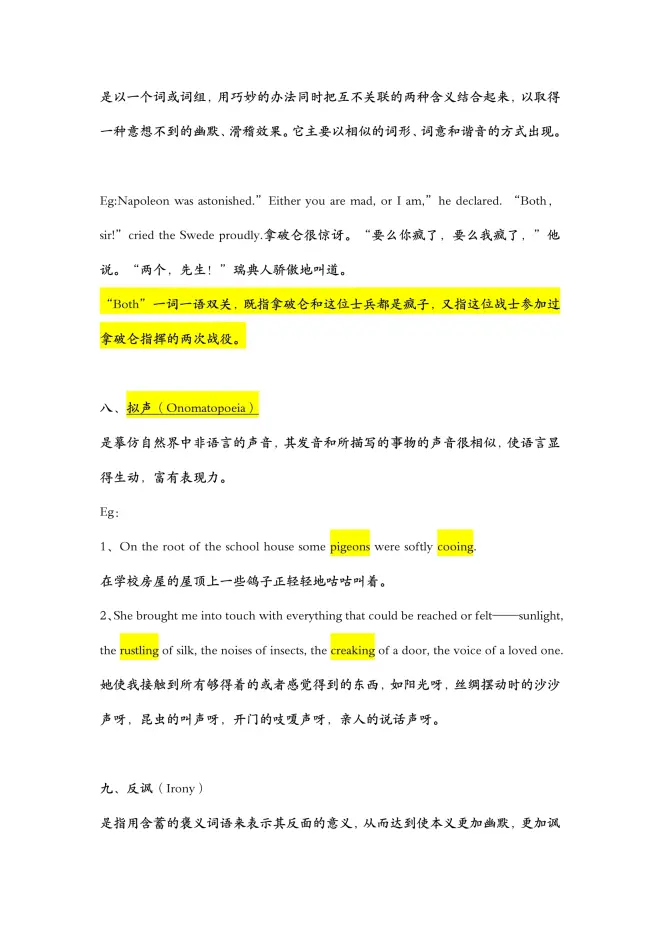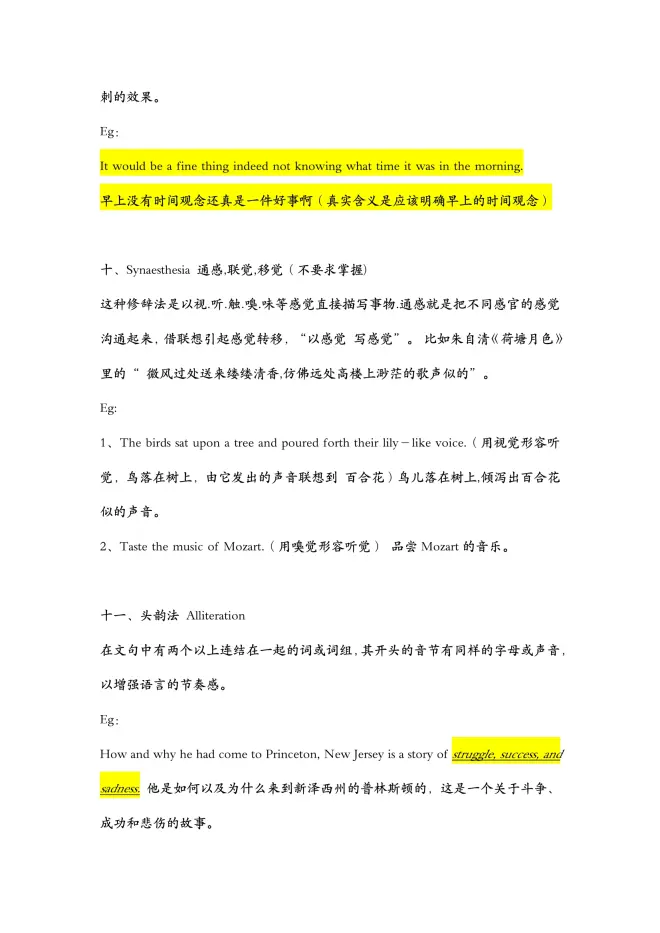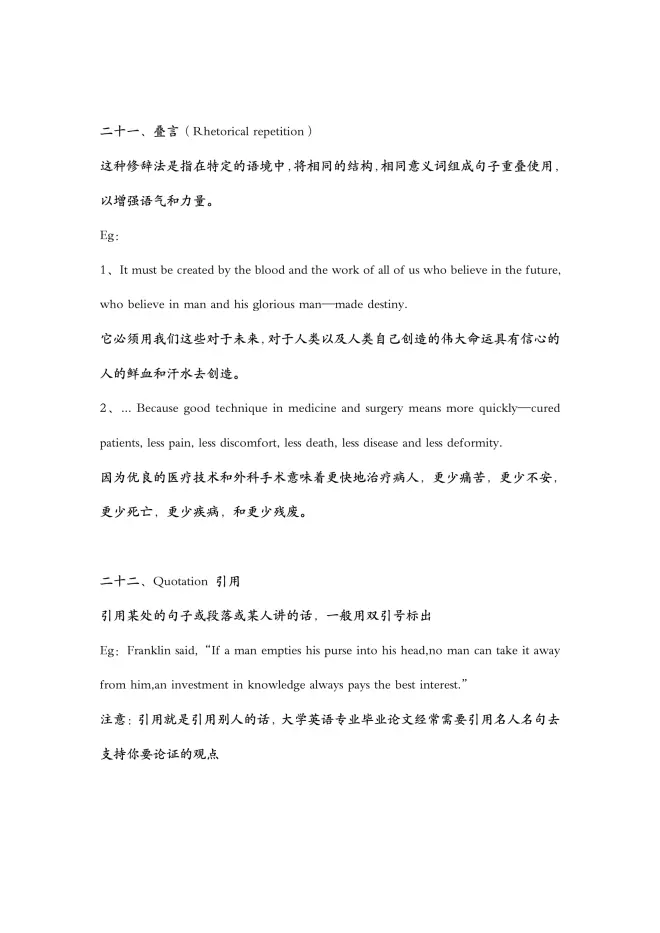Figure of Speech in English修辞格

不知道有没有跟我一样的
英专大三党
期末考试要考
修辞
呜呜 偷偷告诉你我们考试的范围:
simile,metaphor,personification,hyperbole,periodic sentence,rhetorical question,alliteration,euphemism,parallelism,antithesis,irony,anti-climax,onomatopoeia,metonymy,synecdoche
独高分不如众高分,特此分享自己整理的英语中的修辞(来自各种网站+上课讲等,例句并非原创) 废话不多说,上干货!!!!!!
一、明喻(Simile)
是以两种具有相同特征的事物和现象进行对比,表明本体和喻体之间的相似关系,两者都在对比中出现。常用比喻词
like, as, as if, as though,seem,similar to, such as
等。 Eg: 1. This elephant is
like
a snake as anybody can see. 这头象和任何人见到的一样像一条蛇。 2. He looked
as if
he had just stepped out of my book of fairytales and had passed me like a spirit. 他看起来好像刚从我的童话书中走出来,像一个幽灵一样从我身边走过。 3. It has long leaves that sway in the wind
like
slim fingers reaching to touch something. 它那长长的叶子在风中摆动,好像伸出纤细的手指去触摸什么东西似的。
明喻判断最简单,关键词定位即判断
二、隐喻(Metaphor)
这种比喻不通过比喻词进行,而是直接将用事物当作乙事物来描写,甲乙两事物之间的联系和相似之处是暗含的。 Eg: 1、The diamond department was
the heart and center of the store.
钻石部是商店的心脏和核心。 2. He is a
pig
.他简直是头猪。(比喻:他是一个像猪一般的人,指肮脏,贪吃的人。) 3. She is a woman
with a stony heart.
她是一个铁石心肠的女人。(比喻:这个女人冷酷无情。) 4.Mark Twain is
a mirror of America
.马克吐温是美国的一面镜子。(用镜子比喻美国的现实,很贴切。)高级英语1 三、提喻(Synecdoche) 提喻大致归纳为四种情况:
a.部分整体互代;
b.以材料代替事物;
c.抽象和具体互代;
d.以个体代替整类。
Eg: 1. Outside,(there is) a sea of
faces
.外面街上,是人的海洋。(以人体的局部代全体,即以faces 表示people) 2. Have you any
coppers
? 你有钱吗?(以材料代事物,即以copper铜喻指coin money铜币) 3. They share the same
roof
.他们住在一起。(以部分代全体,即用roof屋顶,表示house屋子、住宅) 4. He is the
Newton
of this century.他是本世纪的牛顿。(以个体代整类,用Newton表示scientist科学家) 5. It was reported that
China
won the volleyball match.椐报载:在这次排球赛中,中国队赢了。(以国家名称China代该国球队the Chinese Volleyball Team) 6. Life was a
wearing
to him.生活令他感到厌倦。(以抽象代具体,即用wearing喻指a wearing thing令人厌倦的事情) 7.“...saying that it was the most beautiful
tongue
in the world,...” ……他说这是世界上最美的语言。这里用具体的“tongue”代替抽象的“language”。
四、拟人(Personification)
这种修辞方法是把人类的特点、特性加于外界事物之上,使之人格化,以物拟人,以达到彼此交融,合二为一。拟人是把生命赋予无生命的事物. Eg: I was very happy and could hear the
birds singing
in the woods.(把鸟拟人化) 我很高兴,也能听到鸟儿在树林里唱歌。
五、夸张(Hyperbole)
这是运用丰富的想象,过激的言词,渲染和装饰客观事物,以达到强调的效果,也就是夸张化。 Eg:
1.My blood froze.
我的血液都凝固了。
2.When I told our father about this, his heart burst.
当我将这件事告诉我们的父亲时,他的心几乎要迸出来。
3.You are the whole world to me.
你对我来说是整个世界。
六、转喻 (Metonymy)
是指当甲事物同乙事物不相类似,但有密切关系时,可以利用这种关系,以乙事物的名称来取代甲事物,这样的一种修辞手段。转喻的重点不是在“相似”;而是在“联想”。转喻又称换喻,或借代。 Eg: 1.The
kettle
boils.壶水开。------以容器代表内容 (用the kettle壶,表示 the water in the kettle 壶水) 2.
Grey hairs
should be respected.老人应受到尊重。------以个人的特征代表象征 (用Grey hairs白发,表示 old people老人) 3.
The pen
is mightier than
the sword.
笔要比剑更锋利。(用pen笔,表示writing, sword表示war) ---------以资料、工具代表事物 4. a complete
Shakespeare
莎士比亚全集-----以作者代表作品 (用Shakespeare作者代表作品) 七、双关语(Pun) 是以一个词或词组,用巧妙的办法同时把互不关联的两种含义结合起来,以取得一种意想不到的幽默、滑稽效果。它主要以相似的词形、词意和谐音的方式出现。 Eg:Napoleon was astonished.”Either you are mad, or I am,”he declared. “Both,sir!”cried the Swede proudly.拿破仑很惊讶。“要么你疯了,要么我疯了,”他说。“两个,先生!”瑞典人骄傲地叫道。 “Both”一词一语双关,既指拿破仑和这位士兵都是疯子,又指这位战士参加过拿破仑指挥的两次战役。
八、拟声(Onomatopoeia)
是摹仿自然界中非语言的声音,其发音和所描写的事物的声音很相似,使语言显得生动,富有表现力
。 Eg: 1、On the root of the school house some
pigeons
were softly
cooing
. 在学校房屋的屋顶上一些鸽子正轻轻地咕咕叫着。 2、She brought me into touch with everything that could be reached or felt——sunlight, the
rustling
of silk, the noises of insects, the
creaking
of a door, the voice of a loved one. 她使我接触到所有够得着的或者感觉得到的东西,如阳光呀,丝绸摆动时的沙沙声呀,昆虫的叫声呀,开门的吱嗄声呀,亲人的说话声呀。
九、反讽(Irony)
是指用含蓄的褒义词语来表示其反面的意义,从而达到使本义更加幽默,更加讽刺的效果。 Eg:
It would be a fine thing indeed not knowing what time it was in the morning.
早上没有时间观念还真是一件好事啊(真实含义是应该明确早上的时间观念) 十、Synaesthesia 通感,联觉,移觉(不要求掌握) 这种修辞法是以视.听.触.嗅.味等感觉直接描写事物.通感就是把不同感官的感觉沟通起来,借联想引起感觉转移,“以感觉 写感觉”。 比如朱自清《荷塘月色》里的“ 微风过处送来缕缕清香,仿佛远处高楼上渺茫的歌声似的”。 Eg: 1、The birds sat upon a tree and poured forth their lily-like voice.(用视觉形容听觉,鸟落在树上,由它发出的声音联想到 百合花)鸟儿落在树上,倾泻出百合花似的声音。 2、Taste the music of Mozart.(用嗅觉形容听觉) 品尝Mozart的音乐。
十一、头韵法 Alliteration
在文句中有两个以上连结在一起的词或词组,其开头的音节有同样的字母或声音,以增强语言的节奏感。 Eg: How and why he had come to Princeton, New Jersey is a story of
struggle, success, and sadness.
他是如何以及为什么来到新泽西州的普林斯顿的,这是一个关于斗争、成功和悲伤的故事。
十二、Euphemism 委婉,婉辞法
婉辞法指用委婉,文雅的方法表达粗恶,避讳的话。 Eg: 1、He is out visiting the necessary? 他出去方便一下。 2、His relation with his wife has not been
fortunate
. 他与妻子关系不融洽。 3、Deng Xiaoping
passed away
in 1997. (去世) 十三、Parody 仿拟 这是一种模仿名言.警句.谚语,改动其中部分词语,从而使其产生新意的修辞. Eg: 1、Rome was not built in a day, nor in a year. 罗马不是一天建成,也不是一年建成的。 2、A friend in need is a friend to be avoided.患难见真情。
十四、Rhetorical question 修辞疑问(反问)
它与疑问句的不同在于它并不以得到答复为目的,而是以疑问为手段,取得修辞上的效果,其特点是:肯定问句表示强烈否定,而否定问句表示强烈的肯定.它的答案往往是不言而喻的。 Eg: 1、How was it possible to walk for an hour through the woods and see nothing worth of note? 2、Shall we allow those untruths to go unanswered?
也就是中文常说的反问句
十五、Paradox 隽语 这是一种貌似矛盾,但包含一定哲理的意味深长的说法,是一种矛盾修辞法。 Eg: 1、More haste, less speed.欲速则不达 2、The child is the father to the man.(童年时代可决定人之未来)三岁看大,四岁看老。
十六、Antithesis 对照,对比,对偶
这种修辞指将意义完全相反的语句排在一起对比的一种修辞方法。 Eg: 1、You are staying; I am going. 2、Give me liberty, or give me death.
十七、Parallelism 排比, 平行
这种修辞法是把两个或两个以上的结构大体相同或相似,意思相关,语气一致的短语.句子排列成串,形成一个整体。 Eg: 1、
No one can be perfectly
free till all are free;
no one can be perfectly
moral till all are moral;
no one can be perfectly
happy till all are happy. 十八、Allegory 讽喻,比方(原意“寓言”) 意为"换个方式的说法".它是一种形象的描述,具有双重性,表层含义与真正意味的是两回事。 Eg: 1、Make the hay while the sun shines. 表层含义:趁着出太阳的时候晒草 真正意味:趁热打铁 十九、Climax 渐进法,层进法 这种修辞是将一系列词语按照意念的大小.轻重.深浅.高低等逐层渐进,最后达到顶点.可以增强语势,逐渐加深读者印象。 Eg: 1、I am sorry, I am so sorry, I am so extremely sorry. 2、Eye had not seen nor ear heard, and nothing had touched his heart of stone. 二十、Anticlimax 渐降法 与climax相反的一种修辞法,将一系列词语由大到小,由强到弱地排列. Eg: 1、On his breast he wears his decorations, at his side a sword, on his feet a pair of boots. 2、The duties of a soldier are to protect his country and peel potatoes. 二十一、叠言(Rhetorical repetition) 这种修辞法是指在特定的语境中,将相同的结构,相同意义词组成句子重叠使用,以增强语气和力量。 Eg: 1、It must be created by the blood and the work of all of us who believe in the future, who believe in man and his glorious man—made destiny. 它必须用我们这些对于未来,对于人类以及人类自己创造的伟大命运具有信心的人的鲜血和汗水去创造。 2、... Because good technique in medicine and surgery means more quickly—cured patients, less pain, less discomfort, less death, less disease and less deformity. 因为优良的医疗技术和外科手术意味着更快地治疗病人,更少痛苦,更少不安,更少死亡,更少疾病,和更少残废。 二十二、
Quotation 引用,这个跟中文里面一样
引用某处的句子或段落或某人讲的话,一般用双引号标出 Eg:Franklin said,“If a man empties his purse into his head,no man can take it away from him,an investment in knowledge always pays the best interest.” 注意:引用就是引用别人的话,大学英语专业毕业论文经常需要引用名人名句去支持你要论证的观点 中文版本英文翻译练习: 1.水,汹涌奔泻而来,如箭离弦,如马脱缰,如猛虎出山,江水出峡了。 The sentence uses 3 obvious smiles to vividly describe the turbulent river, which compares river to an arrow leaving a bow, a horse running free and a tiger leaving the mountains, and then the river water rushes through the gorge. The overall effect is to create a vivid image of the power and force of the river water as it flows through a gorge. 2.单是周围的短短的泥墙根一带,就有无限趣味。油蛉在这里低唱,蟋蟀们在这里弹琴。 The sentence uses personification to imbue the surrounding mud wall with life and interest, in which the oil bettles sing lowly and the crickets play music here. The effect is to create a whimsical and imaginative atmosphere. 3.他们看见那些受人尊敬的小财东,往往垂着一尺长的诞水。 The sentence uses hyperbole to exaggerate the length of the hanging "water drops" as a sign of respect for the wealthy businessman: They often hang down like a foot-long stream of water to convey the idea that the respect shown to wealthy merchants can be excessive or never-ending. 4.好个国民党政府的“友邦人士”!是些个什么东西! The sentence uses irony in which the speaker expresses sarcasm toward the so-called "friendly countries" of the Nationalist government to express the opposite meaning, showing speaker's negative attitude towards the government. 5.善游者溺,善骑者堕。 The sentence uses parodox in which the being skilled at swimming and riding which typically viewed as positive attriutes, can lead to negative outcomes like drowning and falling. It shows the potential danger of being overconfident in one's abilities. 6.外甥打灯笼---照旧(舅) The sentence uses pun in which homophones“旧”and “舅”appear simultaneously to create a humorous effect by using the pun and show the ralationship between the speaker and his uncle. 7.我从乡下跑到京城里,一转眼已经六年了。 The sentence uses hyperbole in which the exaggeration of how fast time elapses is used to imply the speaker's experiences and changes over time and pave a way for what intends to say in the following part. 8.你等会,我“方便”一下,咱们回头聊。 The sentence uses euphemism in which the word “方便”means to go to the restroom and the speaker expresses his/her natural desire in a polite and indirect way. It indicates the speaker's politeness and indirectes. 9.吟罢低眉无写处,月光如水照缁衣。 The sentences uses simile in which moonlight is compared to water, reflecting its light onto the poet's dark clothing. The comparison creates a vivid and imaginative image which captures the frustration due to no place to write poem and the surprise to notice the beautiful moonlight shining on the poet's clothes. It also uses parallelism, which involves repeating similar language structures in a series of coordinated phrases to emphasize their content and its musicality. 10.五岭逶迤腾细浪,乌蒙磅礴走泥丸。 The sentence uses metophor in which the moutains compare to surging waves of the sea and moving mud sphere, creating a vivid and imaginative image that enhances readers' visual impressions and feelings of the mountains. It also uses parallelism, which involves repeating similar language structures in a series of coordinated phrases to emphasize their content and its musicality. 11.我们都是来自五湖四海,为了一个共同的革命目标,走到一起来了。 The sentence is a periodical sentence, using synecdoche as well, in which at the ending of the sentence, we know what the writer wants to convey and "五湖四海”as a part of world refers to the whole world, emphasing that people are united and strive for the common










今天的分享就到这里啦!每个figure of speech都可以揉开细细讲,如果有时间或者小伙伴的呼声高,我们再继续这个专栏! 菲菲(我的名字是
Isabelle
)要继续死磕期末复习啦~拜拜!

